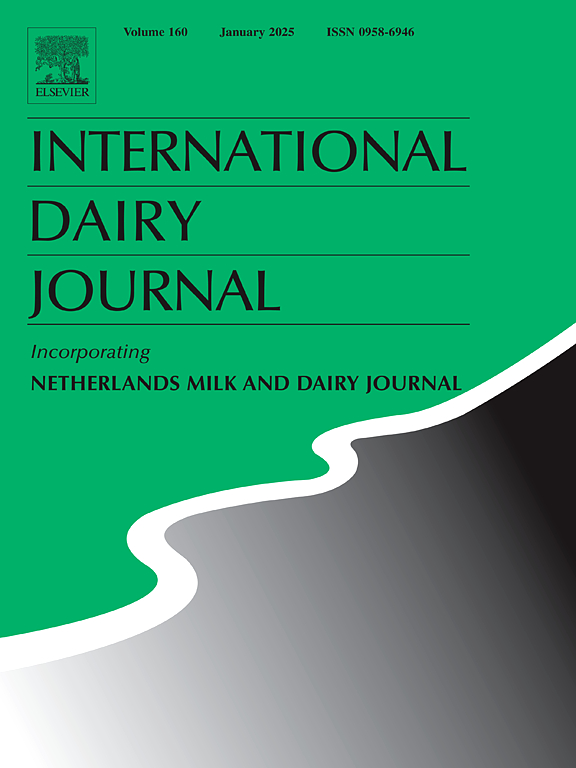乳牛日粮中玉米蛋白粉饲料替代传统精料:对牛奶和奶酪品质的影响
IF 3.4
3区 农林科学
Q2 FOOD SCIENCE & TECHNOLOGY
引用次数: 0
摘要
本研究评估了在含有“Orelha de Elefante Mexicana”草料仙人掌的日粮中,用玉米蛋白饲料(CGF)替代大豆、小麦和玉米麸皮对巴氏消毒全脂牛奶理化特性和手工奶酪理化、微生物学和感官特性的影响。选用8头荷斯坦奶牛,每头体重约为503±31.4 kg,日产奶量为20 kg,采用双拉丁方设计,采用4种饲粮:100%常规精料(CC);66% CC和33% CGF;33% CC, 66% CGF, 100% CGF。我们每天收集两次牛奶样本进行测试。结果显示无显著影响(P >;CGF对牛奶整体性能的影响为0.05),但对牛奶粗蛋白质含量(P = 0.0425)和可滴定酸度(P = 0.0245)的降低呈二次效应。值得注意的是,手工奶酪的水分含量显著降低(P <;0.05),在33%和66%的CGF替代下,分别达到60.09%和58.38%。所有奶酪样品均符合微生物标准,感官评价显示差异显著(P <;0.05)的水分和风味。33%的CGF替代品的购买意愿最高(P <;0.0001)。总体而言,用33%和66%水平的CGF取代传统浓缩物可以提高盈利能力,而不会对牛奶或奶酪质量产生负面影响,从而使乳制品行业受益。本文章由计算机程序翻译,如有差异,请以英文原文为准。
Corn gluten feed as a replacement for conventional concentrate in diets for lactating cows: impact on milk and cheese quality
This study evaluated the impact of replacing soybean, wheat, and corn brans with corn gluten feed (CGF) in diets containing “Orelha de Elefante Mexicana” forage cactus on pasteurized whole milk physicochemical characteristics and artisanal the physicochemical, microbiological, and sensory properties of artisanal cheese. Eight Holstein cows were used, each weighing about 503 ± 31.4 kg and producing 20 kg of milk per day, in a double Latin square design with four diets: 100 % conventional concentrate (CC); 66 % CC and 33 % CGF; 33 % CC and 66 % CGF, and 100 % CGF. We collected milk samples twice a day for testing. The results showed no significant effect (P > 0.05) of CGF on the overall properties of milk, but there was a quadratic effect was observed for crude protein content (P = 0.0425) and a reduction in titratable acidity (P = 0.0245) with the substitution. Notably, artisanal cheese moisture content significantly decreased (P < 0.05) at 33 % and 66 % CGF substitutions, reaching 60.09 % and 58.38 %, respectively. All cheese samples complied with microbiological standards, and sensory evaluation revealed significant differences (P < 0.05) in moisture and flavor. The highest purchase intention was observed for the 33 % CGF substitution (P < 0.0001). Overall, replacing conventional concentrate with CGF at 33 % and 66 % levels can improve profitability without negatively affecting milk or cheese quality, benefiting the dairy industry.
求助全文
通过发布文献求助,成功后即可免费获取论文全文。
去求助
来源期刊

International Dairy Journal
工程技术-食品科技
CiteScore
6.50
自引率
9.70%
发文量
200
审稿时长
49 days
期刊介绍:
The International Dairy Journal publishes significant advancements in dairy science and technology in the form of research articles and critical reviews that are of relevance to the broader international dairy community. Within this scope, research on the science and technology of milk and dairy products and the nutritional and health aspects of dairy foods are included; the journal pays particular attention to applied research and its interface with the dairy industry.
The journal''s coverage includes the following, where directly applicable to dairy science and technology:
• Chemistry and physico-chemical properties of milk constituents
• Microbiology, food safety, enzymology, biotechnology
• Processing and engineering
• Emulsion science, food structure, and texture
• Raw material quality and effect on relevant products
• Flavour and off-flavour development
• Technological functionality and applications of dairy ingredients
• Sensory and consumer sciences
• Nutrition and substantiation of human health implications of milk components or dairy products
International Dairy Journal does not publish papers related to milk production, animal health and other aspects of on-farm milk production unless there is a clear relationship to dairy technology, human health or final product quality.
 求助内容:
求助内容: 应助结果提醒方式:
应助结果提醒方式:


